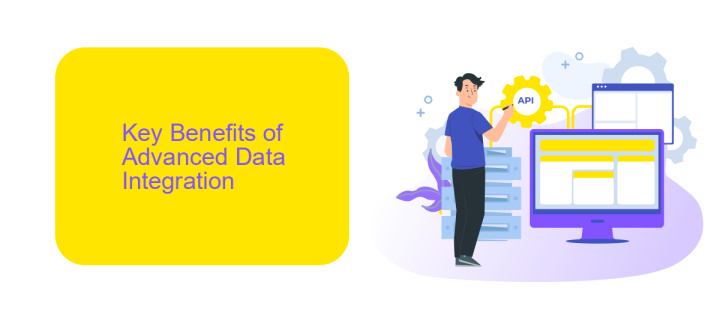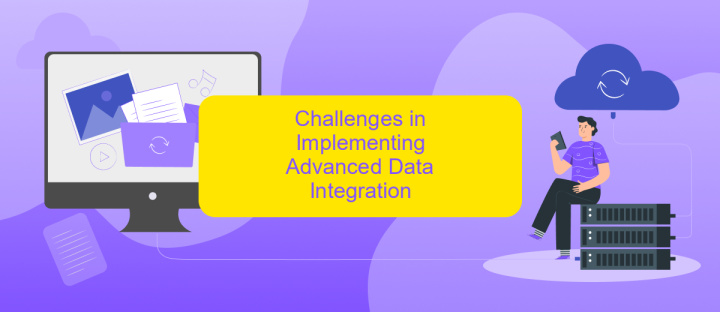Advanced Data Integration
In today's data-driven world, advanced data integration techniques are essential for organizations to harness the full potential of their information assets. By seamlessly combining data from diverse sources, businesses can achieve deeper insights, enhance decision-making, and drive innovation. This article explores cutting-edge strategies and tools that facilitate sophisticated data integration, enabling companies to stay competitive in an ever-evolving digital landscape.
Introduction to Advanced Data Integration
Advanced data integration is a critical aspect of modern business operations, enabling organizations to seamlessly connect disparate data sources and applications. This process ensures that data flows efficiently across various systems, providing a unified view that supports better decision-making and operational efficiency. By leveraging advanced data integration techniques, businesses can overcome challenges related to data silos, inconsistencies, and manual data handling.
- Centralized data management
- Real-time data synchronization
- Enhanced data quality and consistency
- Scalability and flexibility
- Improved decision-making capabilities
Tools like ApiX-Drive facilitate advanced data integration by offering automated workflows that connect different applications and services without requiring extensive coding knowledge. ApiX-Drive supports a wide range of integrations, enabling businesses to streamline their data processes and ensure that critical information is always up-to-date and accessible. By adopting such tools, organizations can significantly reduce the time and effort needed to manage data integration, allowing them to focus on strategic initiatives and growth.
Key Benefits of Advanced Data Integration

Advanced data integration offers numerous key benefits that can significantly enhance business operations. One of the primary advantages is the ability to streamline data from multiple sources into a single, cohesive system. This consolidation not only improves data accuracy and consistency but also enables more efficient data analysis and reporting. By having a unified view of data, companies can make more informed decisions, identify trends, and uncover insights that would otherwise remain hidden in disparate data silos.
Another significant benefit is the reduction of manual data entry and associated errors. Advanced data integration tools, such as ApiX-Drive, automate the process of data synchronization between various applications and services. This automation not only saves time but also ensures that data is up-to-date and accurate across all platforms. Furthermore, these tools can be easily configured to meet specific business needs, offering flexibility and scalability. By leveraging advanced data integration, businesses can improve operational efficiency, reduce costs, and ultimately drive better business outcomes.
Challenges in Implementing Advanced Data Integration

Implementing advanced data integration presents several challenges that organizations must navigate to ensure seamless and efficient data flow. These challenges can range from technical issues to organizational hurdles that require strategic planning and execution.
- Data Quality and Consistency: Ensuring that data from multiple sources is accurate, consistent, and up-to-date can be a significant challenge.
- Scalability: As data volumes grow, the integration solution must be able to scale accordingly without compromising performance.
- Security and Compliance: Protecting sensitive data and adhering to regulatory requirements is crucial in any data integration process.
- Complexity of Integration: Integrating diverse data sources, especially legacy systems, can be technically complex and resource-intensive.
- Real-time Data Processing: Achieving real-time data integration requires robust and efficient processing capabilities.
To address these challenges, organizations can leverage advanced tools and services like ApiX-Drive, which simplifies the integration process. ApiX-Drive offers a user-friendly interface and robust features that help automate data integration, ensuring data quality and consistency while providing scalability and security. By using such tools, businesses can overcome integration complexities and achieve efficient, real-time data processing.
Solutions for Overcoming Advanced Data Integration Challenges

Advanced data integration presents numerous challenges, including data silos, inconsistent data formats, and real-time data synchronization. These issues can significantly hinder the efficiency and accuracy of business operations, making it crucial to adopt effective solutions to overcome them.
One of the primary strategies for tackling these challenges is to utilize robust integration platforms that facilitate seamless data flow between disparate systems. These platforms can automate data synchronization, ensuring that all systems have access to the most up-to-date information.
- Employing ETL (Extract, Transform, Load) tools to standardize data formats and ensure consistency.
- Using API-based integration services like ApiX-Drive to automate and streamline data transfers between applications.
- Implementing data governance frameworks to maintain data quality and compliance.
- Adopting cloud-based integration solutions for scalability and flexibility.
By leveraging these solutions, businesses can significantly reduce the complexities associated with advanced data integration. Services like ApiX-Drive offer a user-friendly interface and powerful automation capabilities, making it easier to connect various applications and ensure smooth data flow across the organization.
- Automate the work of an online store or landing
- Empower through integration
- Don't spend money on programmers and integrators
- Save time by automating routine tasks
Future Trends in Advanced Data Integration
The future of advanced data integration is poised to be shaped by several key trends. One significant trend is the increasing adoption of artificial intelligence and machine learning to automate and optimize data integration processes. These technologies will enable systems to predict integration needs, identify and resolve data discrepancies, and streamline workflows with minimal human intervention. Additionally, the rise of cloud-based integration platforms will continue, providing scalable and flexible solutions that can handle the growing volume and complexity of data from diverse sources.
Another important trend is the emphasis on real-time data integration, driven by the need for businesses to make faster and more informed decisions. Real-time integration tools, such as ApiX-Drive, are becoming essential for organizations seeking to synchronize data across multiple applications instantly. ApiX-Drive, for instance, offers a user-friendly interface and powerful automation features that simplify the setup and management of integrations, making it easier for businesses to maintain data consistency and accuracy. As data privacy regulations become stricter, advanced data integration solutions will also need to incorporate robust security measures to protect sensitive information.
FAQ
What is Advanced Data Integration?
Why is data integration important for businesses?
What are the common challenges in data integration?
How can automation tools help in advanced data integration?
What is ApiX-Drive and how does it facilitate data integration?
Strive to take your business to the next level, achieve your goals faster and more efficiently? Apix-Drive is your reliable assistant for these tasks. An online service and application connector will help you automate key business processes and get rid of the routine. You and your employees will free up time for important core tasks. Try Apix-Drive features for free to see the effectiveness of the online connector for yourself.


